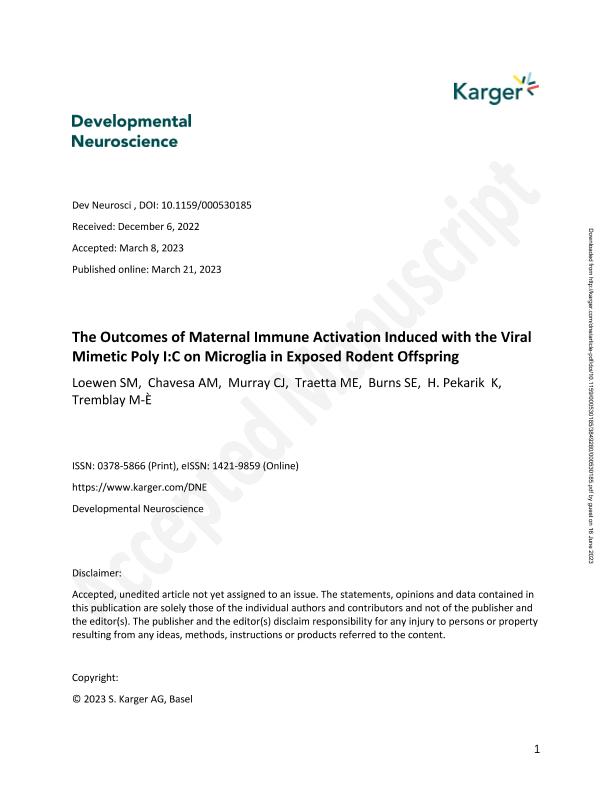Mostrar el registro sencillo del ítem
dc.contributor.author
Loewen, Sophia M.
dc.contributor.author
Chavesa, Adriano M.
dc.contributor.author
Murray, Colin J.
dc.contributor.author
Traetta, Marianela Evelyn

dc.contributor.author
Burns, Sophia E.
dc.contributor.author
Pekarik, Keelin H.
dc.contributor.author
Tremblay, Marie Ève
dc.date.available
2024-02-21T13:15:57Z
dc.date.issued
2023-03
dc.identifier.citation
Loewen, Sophia M.; Chavesa, Adriano M.; Murray, Colin J.; Traetta, Marianela Evelyn; Burns, Sophia E.; et al.; The Outcomes of Maternal Immune Activation Induced with the Viral Mimetic Poly I:C on Microglia in Exposed Rodent Offspring; Karger; Developmental Neuroscience; 45; 4; 3-2023; 191-209
dc.identifier.issn
0378-5866
dc.identifier.uri
http://hdl.handle.net/11336/227764
dc.description.abstract
Maternal immune activation (MIA) can result from a variety of maternal inflammatory factors, including metabolic disorders, nutritional deficits, infections, and psychosocial stress. MIA has been consistently recognized as a major risk factor for neurodevelopmental disorders, and this association seems to be especially important for viral infections as viral exposure during pregnancy was associated with a higher risk of developing neurodevelopmental disorders, such as schizophrenia. In MIA, the gestational parent's inflammatory response to an immune stimulus alters or interrupts fetal development, triggering neurodevelopmental consequences. As MIA can occur in any pregnancy, it is important to understand the many factors at play that contribute to altered brain development in the offspring, especially considering recent global events such as the COVID-19 pandemic. The underlying mechanisms by which MIA results in deleterious outcomes are not yet clear, but due to the inflammatory response it initiates, it is becoming apparent that microglia are critically involved. Through investigation of MIA animal models, the role of microglia in this field is becoming more evident. Compelling evidence from animal models indicates that MIA can disrupt synaptic pruning, neuronal progenitor cell proliferation/differentiation, oligodendrogenesis, and more. Microglia appear as an active player, assisting these neural-related functions during healthy development but also mediating MIA-induced disturbances in these critical processes when neurodevelopment is challenged. The present review illustrates this complex web by reviewing recent literature, focusing on the outcomes of MIA resulting from viral mimetic polyinosinic-polycytidylic acid in rodents, to provide a clear description of how MIA impacts microglial functions and what this means for the offspring's neurodevelopment. Moreover, we discuss the possible implications of the COVID-19 pandemic on the neurodevelopment of the current and next generations in the frame of MIA models and propose some putative pharmacological and non-pharmacological approaches to prevent or attenuate MIA consequences.
dc.format
application/pdf
dc.language.iso
eng
dc.publisher
Karger

dc.rights
info:eu-repo/semantics/openAccess
dc.rights.uri
https://creativecommons.org/licenses/by-nc-sa/2.5/ar/
dc.subject
MATERNAL IMMUNE ACTIVATION
dc.subject
MICROGLIA
dc.subject
POLYINOSINIC-POLYCYTIDYLIC ACID
dc.subject.classification
Neurociencias

dc.subject.classification
Medicina Básica

dc.subject.classification
CIENCIAS MÉDICAS Y DE LA SALUD

dc.title
The Outcomes of Maternal Immune Activation Induced with the Viral Mimetic Poly I:C on Microglia in Exposed Rodent Offspring
dc.type
info:eu-repo/semantics/article
dc.type
info:ar-repo/semantics/artículo
dc.type
info:eu-repo/semantics/publishedVersion
dc.date.updated
2024-02-20T12:45:01Z
dc.journal.volume
45
dc.journal.number
4
dc.journal.pagination
191-209
dc.journal.pais
Suiza

dc.journal.ciudad
Basel
dc.description.fil
Fil: Loewen, Sophia M.. University of Victoria; Canadá
dc.description.fil
Fil: Chavesa, Adriano M.. University of Victoria; Canadá
dc.description.fil
Fil: Murray, Colin J.. University of Victoria; Canadá
dc.description.fil
Fil: Traetta, Marianela Evelyn. Universidad de Buenos Aires. Facultad de Farmacia y Bioquímica. Departamento de Farmacología. Cátedra de Farmacología; Argentina. Consejo Nacional de Investigaciones Científicas y Técnicas. Oficina de Coordinación Administrativa Houssay. Instituto de Biología Celular y Neurociencia "Prof. Eduardo de Robertis". Universidad de Buenos Aires. Facultad de Medicina. Instituto de Biología Celular y Neurociencia; Argentina
dc.description.fil
Fil: Burns, Sophia E.. University of Victoria; Canadá
dc.description.fil
Fil: Pekarik, Keelin H.. University of Victoria; Canadá
dc.description.fil
Fil: Tremblay, Marie Ève. University of Victoria; Canadá
dc.journal.title
Developmental Neuroscience

dc.relation.alternativeid
info:eu-repo/semantics/altIdentifier/url/https://www.karger.com/Article/FullText/530185
dc.relation.alternativeid
info:eu-repo/semantics/altIdentifier/doi/http://dx.doi.org/10.1159/000530185
Archivos asociados
